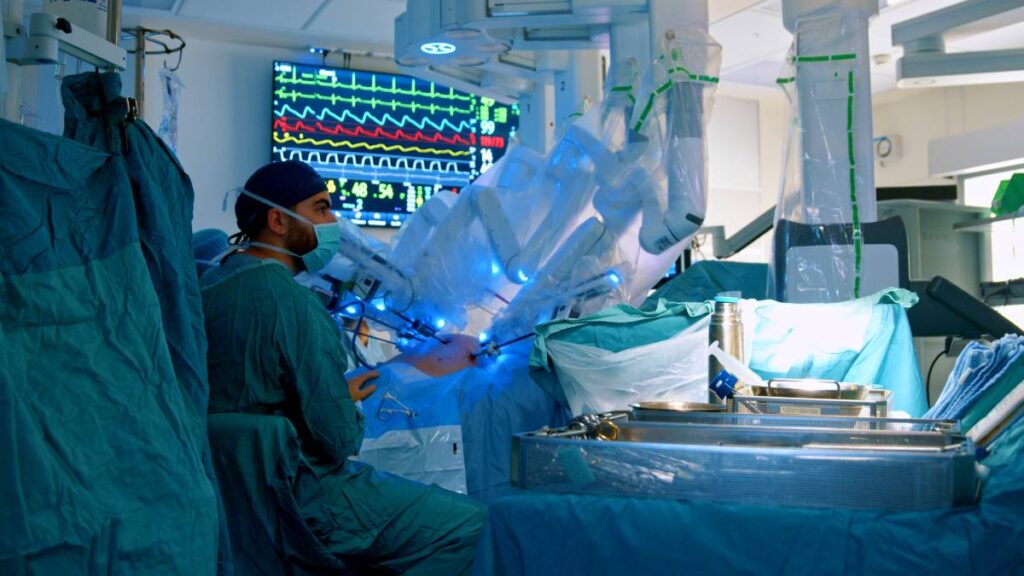Anesthesia management in patients with cardiac conditions requires meticulous planning and a solid understanding of the underlying pathophysiology. While common cardiac diseases like ischemic heart disease and hypertension are frequently encountered, several less common conditions pose unique challenges to anesthesiologists. These uncommon cardiac conditions can significantly impact anesthesia management, requiring specialized knowledge and tailored strategies to ensure patient safety and optimal outcomes.
Hypertrophic Cardiomyopathy
Hypertrophic cardiomyopathy is a genetic disorder characterized by abnormal thickening of the heart muscle, particularly the left ventricle. This thickening can obstruct blood flow and impair the heart’s ability to pump effectively, leading to symptoms like shortness of breath, chest pain, and arrhythmias 1.
In patients with hypertrophic cardiomyopathy, increasing the heart’s contractility can worsen outflow tract obstruction. Therefore, anesthetics that increase sympathetic tone should be used cautiously or avoided. In addition, sudden decreases in systemic vascular resistance can exacerbate obstruction. Vasodilators should be used with caution, and agents that maintain or slightly increase afterload may be preferred. Finally, tachycardia can worsen the outflow obstruction, so beta-blockers or calcium channel blockers may be used to control heart rate and maintain adequate diastolic filling 2–4.
Arrhythmogenic Right Ventricular Cardiomyopathy
Arrhythmogenic right ventricular cardiomyopathy is a rare, inherited cardiomyopathy characterized by the replacement of the right ventricular myocardium with fatty and fibrous tissue. This condition increases the risk of life-threatening ventricular arrhythmias and sudden cardiac death 5.
Patients with arrhythmogenic right ventricular cardiomyopathy are highly susceptible to ventricular arrhythmias, particularly under stress. Anesthetic agents that minimize the risk of arrhythmias are preferred. In addition, excessive sympathetic stimulation can trigger arrhythmias. Therefore, careful management of pain, anxiety, and blood pressure is essential. Finally, abnormal electrolyte levels can exacerbate arrhythmias, so close monitoring and correction of electrolytes are crucial during the perioperative period 6–9.
Brugada Syndrome
Brugada syndrome is an uncommon disorder which also falls into the group of cardiac conditions caused by genetic mutations and complicates anesthesia management. The mutation in Brugada syndrome affects the sodium channels in the heart, predisposing patients to ventricular fibrillation and sudden cardiac death, often in the absence of structural heart disease. The condition is associated with characteristic electrocardiogram changes, including ST-segment elevation in the right precordial leads 10.
Certain drugs, particularly those affecting sodium channels, can unmask or exacerbate the arrhythmic potential in Brugada syndrome. Anesthetic regimens should avoid these agents when possible. Furthermore, hyperthermia can provoke arrhythmias in Brugada syndrome, so maintaining normothermia during surgery is critical. Finally, continuous electrocardiography monitoring, including the right precordial leads, is essential to detect any characteristic changes or arrhythmias during anesthesia 11–13.
Eisenmenger Syndrome
Eisenmenger syndrome develops as a complication of congenital heart defects with a left-to-right shunt that eventually reverses due to pulmonary hypertension, leading to cyanosis. Patients with Eisenmenger syndrome present unique challenges for anesthetic and surgical management due to their complex hemodynamics and the presence of chronic hypoxemia 14.
Systemic hypotension can worsen right-to-left shunting and exacerbate hypoxemia, meaning vasopressors may be required to maintain adequate systemic blood pressure. In addition, avoiding increases in pulmonary vascular resistance is crucial—hypoxia, hypercarbia, and acidosis should be avoided, and careful consideration should be given to the use of inhaled nitric oxide or phosphodiesterase inhibitors to manage pulmonary pressures. Finally, maintaining adequate oxygenation without increasing pulmonary pressures is a delicate balance, and supplemental oxygen should be used cautiously 15–18.
Conclusion
Uncommon cardiac conditions like hypertrophic cardiomyopathy, arrhythmogenic right ventricular cardiomyopathy, Brugada syndrome, and Eisenmenger syndrome present significant challenges in anesthesia management, requiring a deep understanding of the pathophysiology of the conditions and a tailored anesthesia regimen.
References
1. Hypertrophic cardiomyopathy – Symptoms and causes – Mayo Clinic. Available at: https://www.mayoclinic.org/diseases-conditions/hypertrophic-cardiomyopathy/symptoms-causes/syc-20350198.
2. Vives, M. & Roscoe, A. Hypertrophic cardiomyopathy: Implications for anesthesia. Minerva Anestesiologica (2014).
3. Nama, R., Parikh, G. & Patel, H. Anesthetic management of a patient with hypertrophic cardiomyopathy with atrial flutter posted for percutaneous nephrolithotomy. Anesth. Essays Res. (2015). doi:10.4103/0259-1162.156372
4. Davies, M. R. & Cousins, J. Cardiomyopathy and anaesthesia. Contin. Educ. Anaesth. Crit. Care Pain 9, 189–193 (2009). doi: 10.1093/bjaceaccp/mkp032
5. Arrhythmogenic Right Ventricular Cardiomyopathy | Cedars-Sinai. Available at: https://www.cedars-sinai.org/health-library/diseases-and-conditions/a/arrhythmogenic-right-ventricular-dysplasia.html.
6. Kato, Y. & Hayashi, Y. Anesthetic management of patients with arrhythmogenic right ventricular cardiomyopathy. Japanese J. Anesthesiol. (2014).
7. Ohyama, Y., Hoshijima, H. & Shimada, J. Anesthetic management in a patient with arrhythmogenic right ventricular cardiomyopathy and an implantable cardioverter defibrillator: a case report. Brazilian J. Anesthesiol. (2020). doi:10.1016/j.bjan.2020.02.002
8. Alexoudis, A. K., Spyridonidou, A. G., Vogiatzaki, T. D. & Latrou, C. A. Anaesthetic implications of arrhythmogenic right ventricular dysplasia/cardiomyopathy. Anaesthesia (2009). doi:10.1111/j.1365-2044.2008.05660.x
9. Blaskovics, I. & Valchanov, K. Anaesthesia for patients with arrhythmogenic right ventricular dysplasia. http://www.wjgnet.com/ 5, 44–53 (2016). doi: 10.5313/wja.v5.i3.44
10. Brugada syndrome – Symptoms & causes – Mayo Clinic. Available at: https://www.mayoclinic.org/diseases-conditions/brugada-syndrome/symptoms-causes/syc-20370489.
11. Ranucci, M. Challenge of Anesthesia Management in Brugada Syndrome. Anesthesiology 132, 411–412 (2020). DOI: 10.1097/ALN.0000000000003099
12. Cuttone, G. et al. Anesthesiological management of Brugada syndrome patients: A systematic review. Saudi J. Anaesth. 17, 394 (2023). doi: 10.4103/sja.sja_205_23
13. Şahinkaya, H. H., Yaşar, E., Tekgül, Z. T., Horsanalı, B. Ö. & Özeroğlu, E. Anaesthetic Management of a Patient with Brugada Syndrome. Turkish J. Anaesthesiol. Reanim. 44, 96 (2016). doi: 10.5152/TJAR.2016.22230
14. Eisenmenger syndrome – Symptoms and causes – Mayo Clinic. Available at: https://www.mayoclinic.org/diseases-conditions/eisenmenger-syndrome/symptoms-causes/syc-20350580.
15. Bennett, J. M., Ehrenfeld, J. M., Markham, L. & Eagle, S. S. Anesthetic management and outcomes for patients with pulmonary hypertension and intracardiac shunts and Eisenmenger syndrome: A review of institutional experience. J. Clin. Anesth. (2014). doi:10.1016/j.jclinane.2013.11.022
16. Gurumurthy, T., Hegde, R. & Mohandas, B. S. Anaesthesia for a patient with Eisenmenger’s syndrome undergoing caesarean section. Indian J. Anaesth. (2012). doi:10.4103/0019-5049.98780
17. Bala, R., Pirkad, A., Saini, S. & Banerjee, A. Anesthetic management of a patient with Eisenmenger syndrome: What next when one technique fails? Anaesthesia, Pain Intensive Care (2016).
18. Calaia, R. et al. The Anesthetic Complexity of Eisenmenger Syndrome: A Clinical Case. Cureus (2024). doi:10.7759/cureus.54285
